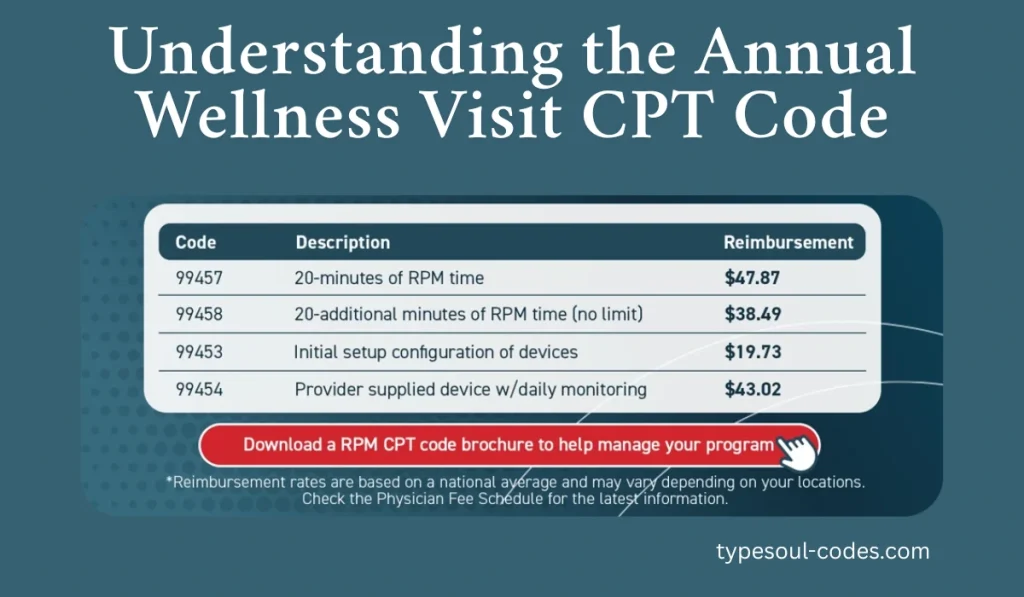Annual Wellness Visits (AWVs) play a key role in preventive healthcare for people enrolled in Medicare Part B. These visits are meant to help identify risk factors, prevent serious illness, and build a clear plan for ongoing care. To ensure full reimbursement and reduce billing errors, providers need to understand the correct Annual Wellness Visit CPT Code used for each type of visit. This guide will walk you through all the important details, including who qualifies, which codes to use, and how to properly bill for these services in 2025.
What Is an Annual Wellness Visit?
An Annual Wellness Visit is a yearly health check-in covered by Medicare. It is not a physical exam, but instead a preventive screening used to create a Personalized Prevention Plan. This helps patients stay healthy, avoid unnecessary procedures, and detect early signs of illness. Unlike traditional checkups, an AWV focuses on reviewing health history, identifying risk factors, and planning future care.
The Centers for Medicare & Medicaid Services (CMS) allows these visits once every 12 months. Each visit must follow a defined set of procedures. The key to getting paid for these services lies in using the right annual wellness visit CPT code at the right time.
Understanding the Annual Wellness Visit CPT Code

There are three main CPT codes that relate to Annual Wellness Visits. Each one applies to a specific type of visit and depends on when the patient enrolled in Medicare or last had a wellness visit.
Read more: Where is 352 area code
Initial Preventive Physical Examination (G0402)
This CPT code refers to the “Welcome to Medicare” visit. A patient can receive this only once in their lifetime, and only within the first 12 months of enrolling in Medicare Part B. This visit includes vital signs, vision screening, and a general health assessment. The G0402 CPT code is rejected if used after the first year of enrollment.
Initial Annual Wellness Visit (G0438)
This is the first true Annual Wellness Visit that happens after the first year of enrollment. If a patient did not get the G0402 visit, they can still qualify for G0438 after 12 months of being on Medicare. It includes cognitive assessments, a health risk assessment, medical history, and setting goals for care. Providers must only use this annual wellness visit CPT code once in a patient’s lifetime.
Subsequent Annual Wellness Visit (G0439)
This is the follow-up AWV code that is used every year after G0438. The patient must wait at least 11 months since their last wellness visit to be eligible. This visit updates the health plan created during the previous visit, and it helps keep track of changing health risks and preventive needs.
Key Requirements for Billing AWVs
Every Annual Wellness Visit must include specific services to qualify for reimbursement. These services help ensure that the visit meets CMS guidelines. If any step is skipped, the claim may be denied, even if the correct annual wellness visit CPT code is used.
Some required components include a health risk assessment (HRA), a review of personal and family medical history, measurement of vital signs, screening for cognitive issues, and developing a personalized screening schedule.
AWV Types and CPT Codes
| Visit Type | CPT Code | Frequency | Key Details |
|---|---|---|---|
| Welcome to Medicare (IPPE) | G0402 | Once, within first 12 months | Focused on baseline screening |
| Initial Annual Wellness Visit | G0438 | Once, after 12 months enrollment | Health risk review and care plan setup |
| Subsequent Annual Wellness Visit | G0439 | Yearly, after G0438 | Updates to previous plans and assessments |
Who Can Perform and Bill for an AWV?
Many healthcare professionals are allowed to conduct and bill for an Annual Wellness Visit. This includes physicians, nurse practitioners, physician assistants, and clinical nurse specialists. These providers must have a valid National Provider Identifier (NPI). Clinical staff such as registered nurses or health educators can perform parts of the AWV under direct supervision.
Specialists such as cardiologists or neurologists can also perform AWVs, but only once per year per patient. If two providers submit the same annual wellness visit CPT code in a single year for the same patient, Medicare will deny the second claim.
Additional CPT Codes for Extended AWV Services
In some cases, other services may be offered during an AWV. These services have their own CPT codes but can be billed on the same day, increasing both patient benefit and provider revenue.
Advance Care Planning (CPT 99497 and 99498)
Advance Care Planning involves a conversation between the patient and provider about future healthcare wishes, including end-of-life preferences. CPT code 99497 is used for the first 30 minutes of face-to-face discussion. CPT 99498 is an add-on code for each additional 30 minutes.
Social Determinants of Health (CPT G0136)
This code is new and pays providers for discussing social risks, such as food insecurity, transportation issues, or housing concerns. Medicare reimburses providers an average of $18.44 for this discussion.
Obesity Counseling (CPT G0447)
Patients with a Body Mass Index (BMI) of 30 or more qualify for this service. It can be billed alongside an AWV and includes brief 15-minute counseling sessions.
Medicare Billing Requirements and ICD-10 Codes
To submit an AWV claim, providers must include five key elements:
- The correct CPT code (G0402, G0438, or G0439)
- A valid ICD-10 diagnosis code, typically Z00.00 for general wellness
- Date and place of service
- Provider’s NPI number
- A documented summary of the visit in the patient record
Correct documentation is vital. If the visit lacks proper documentation or does not meet service requirements, the billing claim may be denied even if the correct annual wellness visit CPT code is used.
Annual Wellness Visit vs Physical Exam
Many patients and even some providers confuse AWVs with annual physical exams. However, they are very different services. A physical exam involves a hands-on checkup that evaluates physical health and may include labs. In contrast, an AWV is a planning-focused appointment that reviews health risks and sets goals.
Medicare does not cover routine physical exams, but it fully covers AWVs once per year. Communicating this clearly to patients helps set expectations and reduce confusion.
AWVs and Value-Based Care
The AWV is a powerful tool in the shift from fee-for-service to value-based care. Because AWVs focus on prevention, they help patients avoid complications and hospitals reduce costs. Providers benefit by building stronger relationships and improving care quality.
When used effectively, the annual wellness visit CPT code becomes more than just a billing number—it’s a gateway to better healthcare outcomes.
Thorough AWV documentation can also help practices identify which patients qualify for additional care management programs, like Chronic Care Management (CCM) or Remote Patient Monitoring (RPM).
Read moe: Is code switching bad
Maximizing the AWV Opportunity
To make the most of AWVs, providers should integrate them into regular workflows. Using software tools like ThoroughCare or RapidAWV can help check patient eligibility, guide documentation, and assign the correct CPT codes automatically.
Building a strong AWV program improves patient engagement, helps close care gaps, and boosts practice revenue.
| CPT Code | Visit Type | When to Use |
|---|---|---|
| G0402 | Welcome to Medicare (IPPE) | Within 12 months of enrollment |
| G0438 | Initial Annual Wellness Visit | After 12 months of Medicare enrollment |
| G0439 | Subsequent Annual Wellness Visit | Yearly, after G0438 |
Frequently Asked Questions
What is the correct annual wellness visit CPT code for new Medicare patients?
The correct code is G0438 if the patient is past the 12-month Medicare enrollment mark and did not receive the initial G0402 exam.
Can I bill G0439 twice in a year?
No, Medicare allows only one AWV per year. You must wait at least 11 full months between visits.
What ICD-10 code should I use with an AWV?
Use Z00.00 for a general adult health checkup with no abnormal findings.
Is the Annual Wellness Visit the same as a physical exam?
No, AWVs focus on health risk planning and do not include physical examination elements.
Conclusion
In 2025, using the right annual wellness visit CPT code is more important than ever. Providers must stay informed, follow CMS requirements, and accurately document each part of the visit. When done correctly, AWVs not only improve care quality but also support your practice’s transition to value-based care. Keep your billing team educated, use smart tools, and prioritize preventive services to make every AWV a success.

